Organization of Contents
State Court Organization utilizes a series of 63 tables to organize its contents. Each of the tables is a matrix (data organized as rows and columns) or series of matrices that displays data on a particular topic, such as Trial Court Funding Sources, Appellate Court Jurisdiction, or Jury Management Systems. The tables are grouped into five sections/subject areas:
- Judicial Branch Governance
- Appellate Courts
- Trial Courts
- Juries
- Technology
Table of Contents
The Table of Contents is the starting point for accessing all State Court Organization information. Each Section is accessed from this page. The content is organized in a hierarchy:
- Table of Contents (links to the five Sections)
- Section Contents Page (links to all the Tables in a Section)
- Table Landing Page (links to all the content in a Table)
- Table Pages (data)

Table of Contents
Sections
Each Section Contents Page provides links to the relevant Tables on blue Table Buttons. Each Table is designated with a number and a title. Use the buttons to go directly to a Table of interest.
![]()
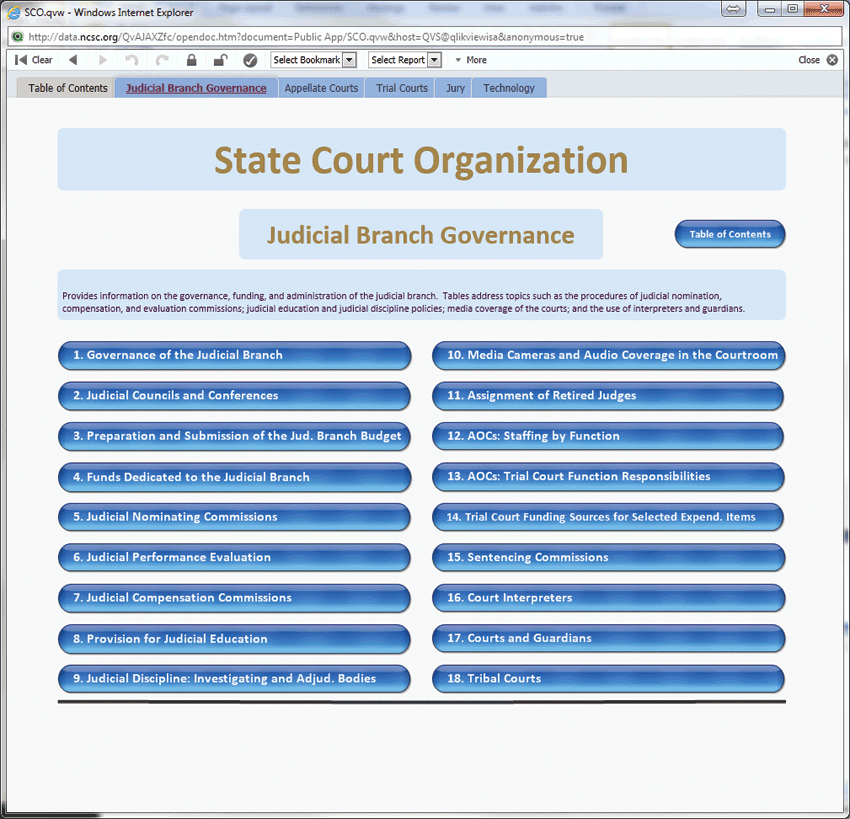
Judicial Branch Governance Section Contents Page
Tables
Each Table contains information on a specific topic and begins with a Table Landing Page. To open a Table Landing Page, click on its Table Button on the Section Contents Page. The Table Landing Page lists all Table Pages as Table Page Buttons and Table Page Tabs, which appear at the top of the window.
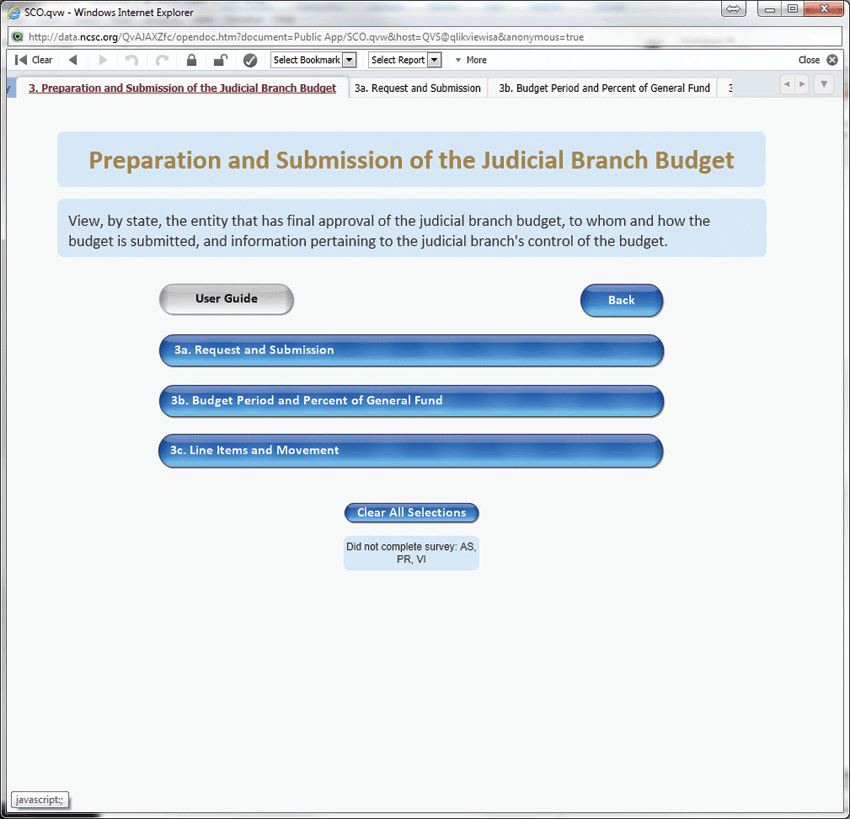
Table 3 Landing Page
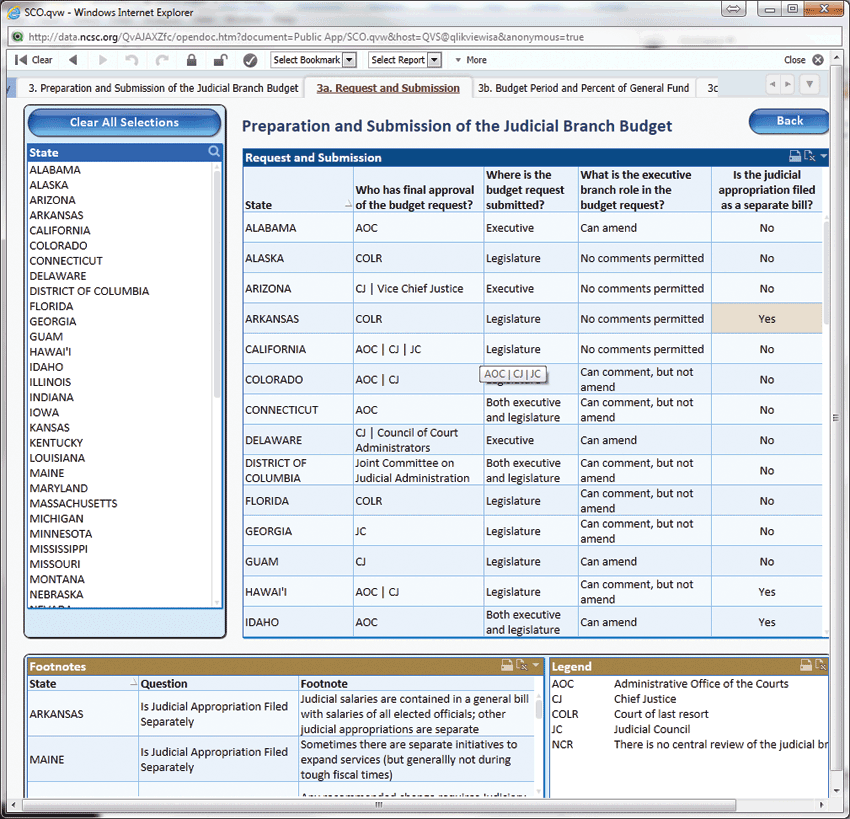
Table Page 3a
Navigation
Navigation within the State Court Organization interface is accomplished by clicking on Buttons or Tabs.
From the Table of Contents page, select a Section by clicking on the blue Button containing its title. You will be directed to a Section Contents Page. On the Section Contents Page you will find buttons that will take you directly to the individual Table Landing Pages. You will also find a blue Table of Contents button that will return you to the main Table of Contents.
The blue Back buttons on the Table Pages will return you to the Section Contents Page for the section you are currently viewing.
An alternate mode of navigation is provided by Tabs located at the top of the window. A Tab for the Table of Contents (grey) and each Section Content Page (blue) are always present. The Tabs for the Table you are currently viewing will also appear and are labeled with Table numbers (e.g., 8a, 8b, 8c) and content. The Table Page you are currently viewing will appear in bold face. From any Table Page you can navigate to other Table Pages within that Table or back to another Section by clicking on the appropriate Tab.
Data Filtering and Sorting
The primary benefit of the State Court Organization interface is the ability to filter the data and see only the information of interest to you. On the left side of each Table Page you will find selection boxes. These boxes contain categories (State, Jurisdiction) you can use to filter the data.
Once on a Table Page, you can select individual states by name and see only data for those states. To narrow the table content to only that which applies to a single state, select that state by clicking on it in the selection box or simply by clicking on that state within the table itself.
To select more than one state in a list of consecutive states:
- Click on the first state and drag to the last state you would like to select.
To select more than one in a list of non-consecutive states:
- Click on the first state you wish to select and then hold the Ctrl key down and click on additional state names. Release the Ctrl key.
The states you have chosen will be highlighted. In the heading of the filtered column (e.g., State), you will see a red dot indicating that a filter is being used to select a subset of the data.
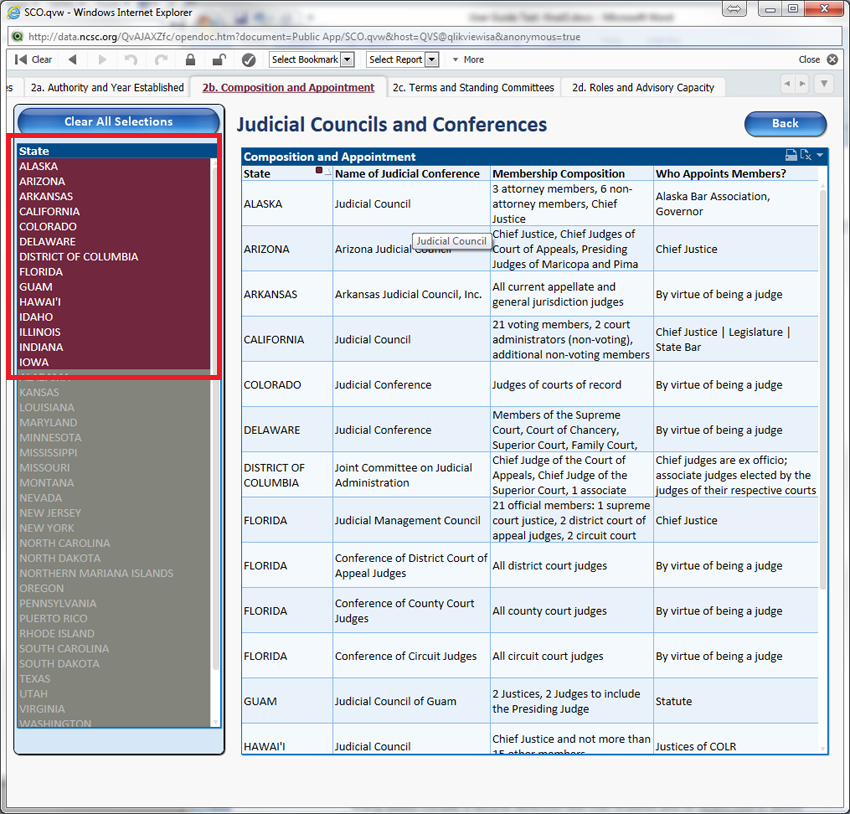
Filtering a subset of the states
Tip: Any selection you make by either of these methods applies to all Table Pages within the Table you are currently viewing. Your selection will be cleared when you return to the Section Contents Page or Table of Contents.
Many tables include a second selection box that enables you to select courts based upon their jurisdiction: limited jurisdiction, general jurisdiction, intermediate appellate court, court of last resort. These selection criteria can be used alone or in conjunction with the state selection criteria described above.
![]()
Filtering by General Jurisdiction Court
The content of any table can also be sorted. To sort the contents of a table, double-click on the heading at the top of the column. Double-clicking on the heading of a column that is not sorted will cause it to sort in ascending order the first time then toggle between descending and ascending each subsequent time. The default sort order for a table is alphabetical by state, and you may return to that order after other sorting procedures by double-clicking once (or twice) on the State heading.
Some tables will contain cells with multiple acronyms/abbreviations that represent data from the state or court. Magnifying glass icons appear in the column headers for these data columns. By clicking on the magnifying glass, a search box will appear and can be used to search within a data column for the data term of interest. Similar to filtering, after entering the acronym or data element of interest in the search box, only states or courts with the specified term will remain in the table.
Note: In order for the search box to correctly identify data of interest, you must type the acronym exactly as it appears in the legend/table.
The Clear All Selections button that appears above the list of states will clear your previous filers (state and jurisdiction) as well as any search box terms. All states will instantly reappear in the table. However, any sorting that was done prior to clearing selections will remain.
In some tables you may find that the cell containing the data is not large enough to display all the text at one time. By hovering your mouse pointer over the cell, a pop-up window will display the full text. When exporting tables with hidden text, all information will be contained in your export file.
Footnotes
Some of the data contained in these tables is footnoted. Footnotes are designed to clarify the content of a cell. If a cell appears shaded in tan, this means there is a corresponding footnote in the Footnotes box at the bottom of the window. Each footnote is individually identified by the state, court (if applicable), and the question to which it pertains. Any state selection performed above will also be applied to the footnotes (i.e., only footnotes pertaining to the selected states will appear).
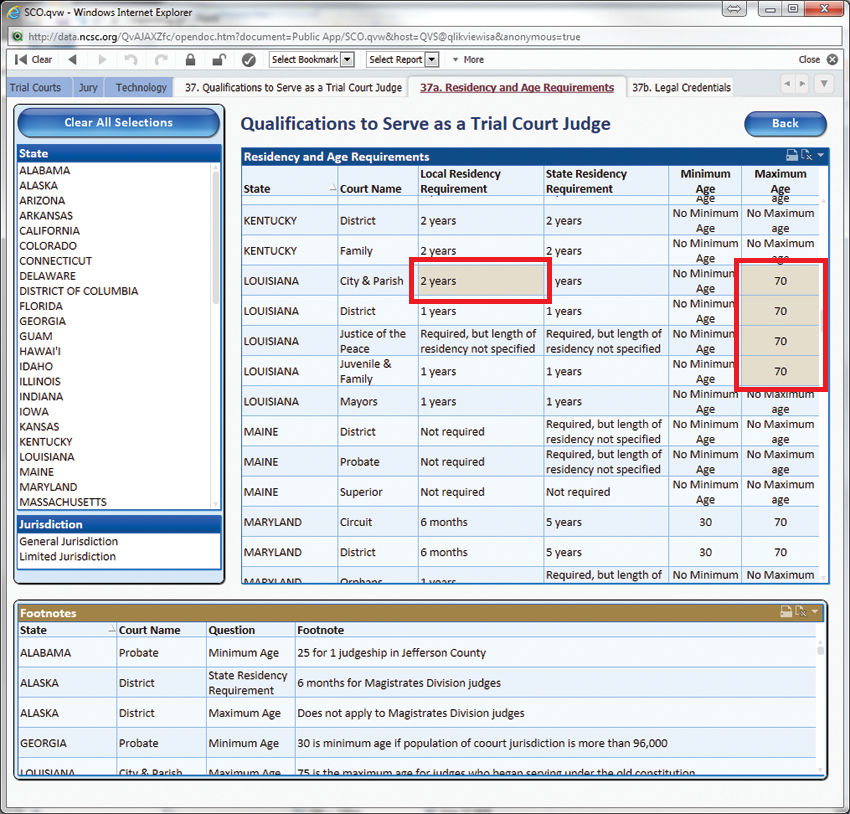
Shaded cells and footnotes
Exporting Content
The Tables included in State Court Organization provide you with the ability to export some or all of the content to Excel or print an image file. Each export function has a unique icon, which appears in the upper right corner of the table. These functions are executed by clicking on their icon once. Exporting content is done separately for the Data, Footnotes, and Legends. For guidance on how to assemble a single report with the multiple exports from one Table see How to Create a Report under Help and Support on the SCO navigation menu.

- Print – will send an image of the entire contents (data) of the Table Page object you are currently viewing. If you have filtered or sorted the content, your selections will be maintained. Footnotes and legends must be printed separately and will have their own print icon in the upper right corner.
- Send to Excel – will open Excel and send the entire contents of the Table Page object you are currently viewing. If you have filtered or sorted the content, your selections will be maintained. Footnotes and legends must be sent to Excel separately and will have their own Excel icon in the upper right corner.
Tip: When exporting data to Excel, Table numbers and titles are not exported, only data. Be sure to add this information into the exported Excel file to avoid confusion. Tables that comprise multiple Table Pages must be assembled in Excel by exporting the contents from each table page individually and then manipulating the results to create the desired aggregate table. For further guidance on how to compile the information from multiple Table Pages see "How to Create a Report" under Help and Support on the SCO Navigation menu.
- Menu – lists the above options of Print and Send to Excel as well as the option to Export (similar to Send to Excel, but is a CSV file and contains no formatting).
Technical Support
If this User Guide does not resolve a difficulty that you experience while using State Court Organization or if the interface appears to be functioning in an unexpected way, please contact the National Center for State Courts by clicking here.
